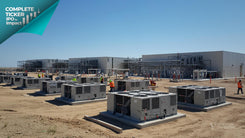The Complete Ticker: Plug Power (PLUG) Stock Analysis: From IPO to Impact

A Company that Keeps Coming Back to the Future
Every few years, Plug Power returns to the center of the clean-tech conversation. The script reads like a modern business parable. The company promises a future powered by hydrogen, markets swoon, reality checks arrive, and then the cycle resets with a new plan and a bigger ambition. What makes Plug’s story worth telling is not just the boom-and-bust rhythm. It is the persistence. The idea of hydrogen as a clean, dispatchable fuel predates most current climate policies. Plug has been trying to commercialize it long enough to live through multiple market regimes and technology waves. In a world that often equates innovation with overnight success, the company’s trajectory shows how long it can actually take to build a market that does not exist yet.
PLUG stock analysis starts with this contradiction. Investors come for the promise of a large market. Operators confront the difficulty of building an end-to-end system: production plants, logistics, storage, fueling, and the equipment that actually uses the fuel. In between are customers with warehouse aisles to keep moving, data centers looking for backup power, and new rules that can shift the economic calculus in a single policy cycle. The real story is how Plug moved from being a fuel cell seller to attempting an integrated hydrogen enterprise, and what it learned when the dream met the details.
From Dot-Com Optimism to an Industrial Proposition
Plug Power listed on Oct. 29, 1999, at the peak of an era when anything with a plausible technology narrative found a welcome on public markets. Hydrogen was not yet a climate solution in the public imagination. It was an elegant science project with friends in auto R&D labs and national energy departments. Plug’s pitch, even then, was audacious: fuel cells could power more than concept cars, and the company would help make that happen at commercial scale.
The early years were hard. Unlike software, fuel cells have to compete with diesel engines, lead-acid batteries, and well-oiled industrial supply chains. The product worked, but the economics were a different challenge. In 2008, Andy Marsh took over as CEO and pushed the company toward a more focused market: material handling. Forklifts are a better proving ground than passenger cars. Distribution centers run on tight schedules and cannot afford downtime swapping heavy batteries. Fuel cells could refuel quickly and keep fleets in motion.
That pivot became the first durable chapter of Plug’s public life. The company aimed to prove hydrogen’s usefulness in the least glamorous corner of logistics. The choice signaled something essential about its culture. It was willing to win the small battles first. By concentrating on warehouse fleets and service contracts rather than consumer hype, Plug built a beachhead. A decade after its IPO, it was less a lab story and more a niche industrial company with a plan.
Building a Market Aisle by Aisle
The next act began when big customers noticed. In 2014, Walmart began ramping deployments of Plug’s fuel cells for forklifts across its distribution centers. The validation unlocked conversations with other national fleets, and suddenly the forklift aisle looked like a platform, not a cul-de-sac. In 2017, Plug announced a commercial partnership with Amazon that included warrants tied to future purchases. The headlines were dramatic, but the operational significance mattered more. Plug was no longer selling hardware in isolation. It was selling uptime, refueling, and the service ecosystem that makes hydrogen a workable option for daily operations.
The company’s growth arc was not a straight line. It rarely is for firms trying to make markets from scratch. But the product-market fit in material handling gave management confidence to look upstream. If the cost and availability of hydrogen were the pinch points, Plug would not wait for someone else to solve them. In 2020, it acquired Giner ELX, a maker of PEM electrolyzers, and United Hydrogen, a producer and distributor. That year marked the shift from being a fuel cell integrator to an aspiring one-stop shop for green hydrogen, with plans for plants, delivery, and on-site fueling.
By Q4 2019, before that upstream bet accelerated, revenue had reached $91.7 million, according to company filings. The number is less important than the narrative it supports. Plug was building real sales and service relationships while laying groundwork for a vertical model. Then policy winds turned favorable. The United States passed the Inflation Reduction Act in 2022, including incentives intended to make low-carbon hydrogen more competitive. Meanwhile, Europe’s energy security crisis amplified interest in alternative fuels. PLUG stock analysis shifted from whether the product worked to whether the integrated model could be executed quickly enough, cheaply enough, and financed on reasonable terms.
Peaks, Restatements, and Reality Checks
Here is where timing and expectations collide. In January 2021, Plug’s shares surged to record highs as investors chased green energy names across the market. That same quarter, the company announced it would restate prior financial statements, a non-cash accounting cleanup that nonetheless dented credibility. The moment captured a truism about early-stage industrial transitions. The market prices the destination, then management has to live through the journey, with all its messy subcontractor relationships, warranty risks, and working capital needs.
The following period tested patience. Building green hydrogen plants is capital intensive. Securing power at the right cost, sourcing cryogenic equipment, and hitting uptime targets are not tweet-length milestones. In November 2023, Plug warned about going-concern risks if it could not access additional financing and manage near-term cash burn. As reported at the time, the stock fell more than 30 percent in the immediate aftermath. For many companies that would have been a breaking point. For Plug it became another pivot. The company raised capital, reprioritized projects, and put more emphasis on near-term revenue and service contracts that could support the heavier lift of plant buildouts.
The longer arc is instructive. Plug has been adept at securing strategic partners, from retail and e-commerce giants to energy companies abroad. It has also had to relearn the basics more than once. Inventory management, reliability across product generations, and pricing power in service agreements all matter as much as electrolyzer efficiency. PLUG stock analysis in this period is less about a quarterly beat or miss and more about operational evidence that the supply chain is maturing. The difference between an idea stock and an industrial company is often a year’s worth of boring execution. Plug has been learning to live in that middle space.
What the Chart Reveals About a Company Growing up in Public
The company’s chart is a palimpsest of the last five years of clean-tech enthusiasm and repricing. A surge into early 2021 reflected abundant capital and a rush into anything tied to decarbonization. The retracement that followed lived in a downtrend defined by lower highs as the market demanded proof of cash generation and reliable plant output. Late 2023 brought capitulation as financing became the storyline. The recovery attempts since then have been more workmanlike, with rallies fading into areas where investors previously bought high and then became reluctant sellers.
PLUG stock prices fell below 10 dollars in the wake of the 2023 warning, a psychological level that reinforced just how far expectations had reset. The trading since has respected the rhythm of a company still in transition. On good news, volume arrives because the float is widely held and the story has a deep bench of followers. On disappointments, sellers cluster quickly because the audience knows the operational checklist by heart. For chart-focused readers, that creates a pattern where inflection points are less about clever trendline drawings and more about whether headline flow maps to the build-out plan the company has put in writing.
This is a case where the technical picture is really a referendum on operational milestones. Are hydrogen plants coming online on-schedule? Are service contracts renewing with better margins? Are upstream electrolyzer shipments converting to downstream fueling revenue? The share price chases those answers, not the other way around.
How Traders Frame PLUG Stock Analysis in Real Time
Short-term traders in Plug tend to sort headlines into two buckets. The first is financing and liquidity. News about credit facilities, equity raises, or project-level funding often outweighs product announcements because it tells the market whether execution can continue without constant dilution. The second is proof points. Plant commissioning, uptime targets, shipped-and-billed electrolyzers, and customer expansion validate the integrated model the company has promised. Neither bucket is glamorous, but they shape tape action more consistently than big-picture narratives.
There is also the customer lens. Material handling contracts are the ballast. They may not light up a presentation, yet they demonstrate repeat business and give the service organization leverage to renegotiate terms as reliability improves. New verticals, from stationary power to mobility pilots, are optionality rather than base case. Traders often discount them until delivery schedules harden and early sites meet the performance spec in the field.
Psychology matters. Plug has a large retail following, and with that comes crowded entries on news spikes. The name rewards patience more than quick reflexes. Moves that begin on policy headlines tend to fade unless they are paired with financing clarity. Rallies that start on commissioning updates can extend if they coincide with commentary about margins, not just megawatts. For many active readers, PLUG stock analysis is an exercise in separating enthusiasm about hydrogen as a theme from the cadence of this specific company’s execution.
If there is a longer-term frame traders keep in the back pocket, it is this. Plug’s ambition to control production, logistics, and end-use gives it multiple ways to create value, but it also loads the balance sheet. The path to a healthier multiple runs through consistent service profitability, measured growth in plant capacity matched to contracted offtake, and a cost of capital that reflects de-risked assets rather than visionary slides. Those are business levers, not chart patterns, yet they show up on screens as steadier reactions to news and more constructive ranges after selloffs.
What the Market Will Reward Next
For a company that began its public life at the turn of the millennium, Plug Power remains oddly early. The market it wants to dominate is still forming. That is the paradox that makes the story compelling. It is neither the overnight success some hoped it would be, nor the cautionary tale some feared. It is an industrial build-out happening in public, quarter by quarter, with a following large enough to make each twist and turn feel bigger than it is.
Two markers help calibrate the present. As of Q4 2019, revenue was $91.7 million, the sign of a real business even before the upstream push. And as of September 2025, its market capitalization sat around $4.5 billion, a reminder that public markets continue to price significant potential into the story. The question now is one of conversion. Can plant commissioning, customer renewals, and financing discipline stack up fast enough to change the conversation from promise to production? If yes, the stock will likely trade less on dream cycles and more on the kind of consistency that industrial investors pay for. If not, it will keep courting volatility from the very audience that first put it on the map.
Either way, the journey from IPO to impact has given Plug a rare asset in clean tech: staying power. That may be the most valuable resource in a business defined by long timelines and even longer memories.
Trading involves substantial risk. All content is for educational purposes only and should not be considered financial advice or recommendations to buy or sell any asset. Read full terms of service.




